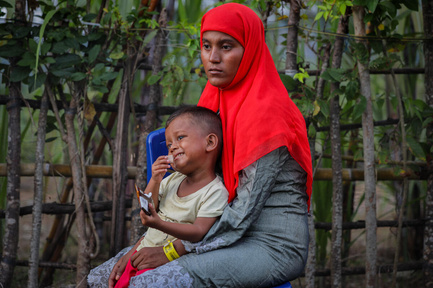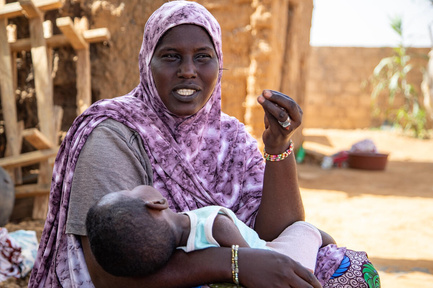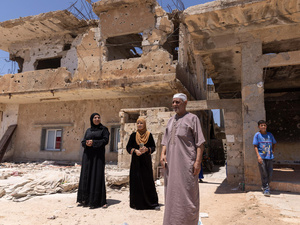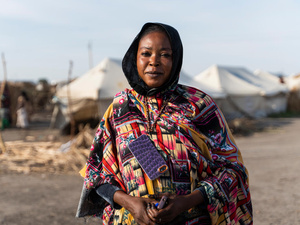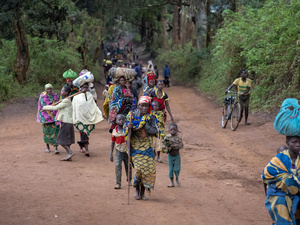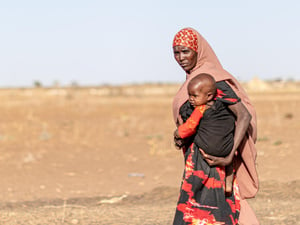Global Trends

Global Trends
Syrian refugees Batool, 9, and her brother Abdulaziz, 7, in the Zaatari refugee camp, Jordan.
At the end of 2024, an estimated 123.2 million people worldwide were forcibly displaced due to persecution, conflict, violence, human rights violations and events seriously disturbing the public order.
This is an increase of 7 million people or 6 per cent compared to the end of 2023. While displacement has almost doubled globally over the last decade, the rate of increase slowed in the second half of 2024. By the end of April 2025, UNHCR estimates that the global number of forcibly displaced people has likely fallen slightly by 1 per cent to 122.1 million, the first decrease in well over a decade.
Whether this trend continues or reverses during the rest of 2025 will largely depend on whether peace or at least a cessation in fighting is possible to achieve, particularly in the Democratic Republic of the Congo, Sudan and Ukraine; whether the situation in South Sudan does not deteriorate further; whether conditions for return improve, in particular in Afghanistan and Syria; and how dire the impact of the current funding cuts will be on the capacity to address forced displacement situations around the world and create conducive conditions for a safe and dignified return.
At the end of 2024, 123.2 million people were forcibly displaced.
This equates to 1 in every 67 people on Earth.
Displacement nearly doubled during the last decade.
The search for peace must be at the heart of all efforts to find long-lasting solutions for refugees and others forced to flee their homes.
People forcibly displaced worldwide | 2015 – 2024
Key displacement situations in 2024
Sudan crisis
The war in Sudan is the world’s largest displacement crisis.
A total of 14.3 million Sudanese people remained displaced at the end of 2024. This was 3.5 million more people than 12 months prior and represents nearly one in three of the national population.
Pictured: Newly arrived Sudanese refugees in the border town of Adre, Chad. © UNHCR/Andrew McConnell
Solutions for forced displacement rose in 2024
Solutions for refugees and internally displaced people all increased during 2024, with refugee returns the highest reported in more than two decades (1.6 million). However, underlying these positive trends with each solution are concerns about the inherent protection risks to forcibly displaced people and the longer-term sustainability of these solutions.
In the past year, 92 per cent of the 1.6 million refugee returns were to only four countries: Afghanistan, Syria, South Sudan and Ukraine. Many Afghan, Syrian and South Sudanese refugees have returned in adverse conditions and arrived in extremely fragile situations. In Ukraine, despite the war entering its fourth year, many vulnerable refugees have chosen to return partly due to challenges in accessing rights and services in host countries. In Afghanistan, returnees have arrived to a country gripped with pervasive poverty, soaring unemployment, severely inadequate public services and widespread food insecurity.
The past year also saw the highest number of refugees resettled to third countries for more than 40 years (188,800). In addition, almost 88,900 refugees obtained their host country’s citizenship or were granted permanent residence in 2024.
More than 8.2 million IDPs also returned to their area of origin in 2024, the second highest total ever recorded. But in the absence of peace and stability in their country, many IDPs remain trapped in cycles of returns followed by new displacement and conflicts are becoming increasingly protracted. Many of these returns therefore may not be sustainable.
Spotlight situations: Three displacement crises in focus
Syria
Text and media 4 - Copy
Syria at a crossroads
The war in Syria produced one of the largest forced displacement crises in the world. By the end of 2024 a quarter of the population was displaced, including 6.1 million Syrian refugees and asylum-seekers and 7.4 million IDPs.
The fall of the Assad government on 8 December generated renewed hope of return, yet the situation remains unstable, with ongoing risks of further new displacement.
As of mid-May, more than 500,000 Syrians are estimated to have crossed back into Syria since the fall of the Assad government. An estimated 1.2 million IDPs have also returned to their areas of origin.
Whether these returns are sustainable will depend on many factors, including the overall development of the security situation within Syria, as well as the availability of housing, public services, infrastructure and the revitalisation of the economy. However, it is estimated that up to 1.5 million Syrians from abroad and 2 million internally displaced people may return by the end of 2025.
UNHCR continues to urge States not to forcibly return Syrians. Many families return to find their homes damaged or destroyed and face significant obstacles in rebuilding their lives. At this pivotal time, it is vital to support Syria’s recovery.
Myanmar
Text and media 1
Desperate journeys of Rohingya refugees
The humanitarian crisis in Myanmar is one of the most complex and protracted in the world. As of March 2025, 3.6 million people were displaced within Myanmar, while 1.5 million had fled the country. Most refugees are Rohingya who fled successive waves of violence and the impact of discriminatory citizenship laws, which have rendered nearly all Rohingya stateless people.
Thousands have embarked on perilous journeys in search of protection. In 2024, around 11,300 people attempted dangerous journeys over land or by boat, an increase of 74 per cent compared to the previous year, although the actual number is thought to be higher. Tragically, around 660 Rohingya refugees were reported as dead or missing at sea in 2024.
UNHCR and partners are implementing a route-based (or panoramic) approach in their response to ensure access to protection and solutions is available as early as possible. UNHCR continues to advocate with States across the region to promote greater coordination to save lives at sea, fully deploy rescue capacities and enable safe and timely disembarkation, thereby upholding the principles of humanity, solidarity and responsibility sharing.
As global crises multiply and humanitarian resources become scarcer, the protection and humanitarian needs of forcibly displaced and stateless people within and from Myanmar must not be overlooked.
The Sahel
Text and media 3
Compounding causes of forced displacement in the Sahel
The number of forcibly displaced people within the Sahel has continued to grow. At the end of 2024, approximately 3.8 million people remained forcibly displaced, and increase of 58 per cent from the end of 2020.
Conflict and insecurity are intensifying, with the region accounting for more than half of all terrorism-related deaths worldwide. Political instability has also deteriorated due to persistent insecurity and economic hardship.
In addition, the region increasingly suffers from extreme weather events. Widespread floods in 2024 affected over 1.5 million people in Niger and 733,000 in Mali. The floods compounded an already challenging situation, with the proportion of the population in the region facing extreme hunger expected to increase by 20 per cent by June 2025.
Most refugees and asylum-seekers (70 per cent) originating from the Sahel remain within the region and rely on the support from neighbouring countries. Despite numerous challenges, countries affected by the crisis continue to show strong political will to support sustainable responses to forced displacement. However, increased investment in the region is crucial to ensure governments can continue to manage and provide viable solutions to the rising numbers of forcibly displaced people.
When referring to forced displacement within the Sahel region, UNHCR uses the term “Sahel Plus” to include Mali, Niger and Burkina Faso (Central Sahel), as well as neighbouring countries affected by displacement from the Central Sahel: Mauritania, Côte d’Ivoire, Benin, Togo, and Ghana.
Return to Syria
The fall of the government on 8 December dramatically shifted the dynamics surrounding refugee returns to Syria, with a growing number of refugees living in neighbouring countries expressing a positive intention to return home.
Pictured: Syrian refugees arrive at the Cilvegözü – Bab Al-Hawa border crossing between Türkiye and Syria to complete a voluntary repatriation process before returning home to Syria. © UNHCR/Emrah Gürel
Forcibly displaced populations
Refugees
Refugees
The global refugee population decreased by 1 per cent to reach 42.7 million during the year. This includes 36.8 million refugees under UNHCR's mandate, including 4 million people in a refugee-like situation and 5.9 million other people in need of international protection, as well as 5.9 million Palestine refugees under UNRWA's mandate.
However, compared to a decade ago, the total number of refugees under UNHCR’s mandate has more than doubled, reaching 36.8 million by the end of 2024.
The number of Afghan and Syrian refugees decreased in 2024, and reporting of Ukrainian refugees was updated. The number of Venezuelans that were refugees (370,200) or other people in need of international protection (5.9 million), increased by 2 per cent from the previous year.
Most refugees remain near their country of origin, with 67 per cent hosted in neighbouring countries at the end of 2024.
Internally displaced people (IDPs)
Internally displaced people (IDPs)
Most people who are forced to flee never cross an international border, remaining displaced within their own countries. Known as internally displaced people, or IDPs, they account for 60 per cent of all forcibly displaced people.
At the end of 2024, 73.5 million people remained internally displaced due to conflict and violence. An estimated 11.6 million people were displaced within Sudan (+2.5 million compared to 2023), and this remains the largest internal displacement crisis ever recorded.
In 2024, 20.1 million new internal displacements were reported due to conflict or violence. Over 60 per cent of these occurred in the Democratic Republic of the Congo, Haiti, Myanmar, Sudan and Ukraine.
Asylum-seekers
Asylum-seekers
There were 8.4 million asylum-seekers awaiting decisions on their individual applications at the end of 2024, the highest number ever recorded, marking a 22 per cent increase from 6.9 million the previous year.
The number of pending asylum claims has risen for eight consecutive years since 2016 as new individual asylum applications have continued to outpace substantive decisions.
During the year, at least 4.8 million people sought international protection, including those that applied for asylum on an individual basis (3.1 million), were recognized through group procedures (835,600) or were granted temporary protection (954,600). Over one-third of the 4.8 million people seeking international protection came from just two countries: Ukraine (879,100) and Sudan (872,400).
Some Palestine refugees under UNRWA’s mandate in Gaza have also been internally displaced. In these figures, they are counted in both the internally displaced people total, and the global total of refugees. However, they are only counted once in total number of displaced people (123.2 million people).
Text and media 4 - Copy
"There is so much talent in the camp. We just need more opportunities to showcase them."
"Basketball is my favorite sport," says Doris, a refugee from South Sudan now living in the Kakuma Refugee Camp in Kenya. "It also keeps youth in the camp away from drugs and for girls it keeps them away from early pregnancies."
A humanitarian system at breaking point
UNHCR and the broader humanitarian community are facing detrimental funding cuts, that will severely impact millions of people globally.
Without sufficient funding, there will not be enough food assistance and basic shelter support for displaced people. Protection services, including safe spaces for refugee women and girls at risk of violence, are likely to be terminated. Communities that have generously hosted forcibly displaced people for years will be left without the support they need. And, perhaps most critically, hopes for returns will either not materialize or the return will not be dignified and will not be accompanied by an increase in adequate services in countries of origin. As a result, people that do return may have no choice but to leave again.
For the number of forcibly displaced people to reduce, meaningful progress is required on the root causes – conflict, disregard for the basic tenets of International Humanitarian Law, other forms of violence and persecution.
In the meantime, resources to meet urgent humanitarian needs, to support host countries, to protect people from the risks of dangerous onward movements and to help refugees and other forcibly displaced people find durable solutions are more essential than ever.
The consequences of inaction will be borne by those who can least afford it.
Without sufficient funding, there will not be enough food assistance and basic shelter support for displaced people.
Download the report and annexes
Text and media 53
Global Trends 2024
UNHCR's Global Trends report presents the latest numbers of refugees, asylum-seekers, internally displaced and stateless persons worldwide.
Download the Global Trends report
Annexes and raw data
About the UNHCR Global Trends and Mid-Year Trends reports
UNHCR releases two flagship statistical reports on global forced displacement each year, the Global Trends report and the Mid-Year Trends report. The Global Trends report, released annually in June, analyses changes and trends in forcibly displaced populations in the previous calendar year (from 1 January to 31 December). It provides key statistics on the global numbers of refugees, asylum-seekers, internally displaced people and stateless people, as well as their main host countries and countries of origin.
In October each year, the Mid-Year Trends report is released to provide updated figures and analysis for the initial six months of the current year (from 1 January to 30 June). These figures are preliminary, and the final data is included in the subsequent Global Trends report.


